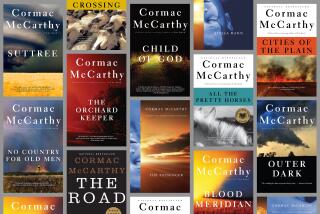Be Kind to Your Pearls : LOVERS, <i> By Judith Krantz (Crown Publishers: $23; 464 pp.)</i>
I believe that the true test of a really great bad book is that you don’t hate yourself until you’ve finished it. It’s embarrassing enough to have to go out of your way to a bookstore where they don’t know you to buy it, and then make sure that nobody that you want to impress catches you reading it. (To my everlasting shame, I once ran into my high school English teacher while I holding “Valley of the Dolls,” perhaps the “War and Peace” of trash literature.) In exchange, a really great bad book should be extremely difficult to put down.
For example, “Lovers,” Judith Krantz’s seventh novel, is the sort of bonbon for the mind designed to get you through a 12-hour plane ride or the weekend after you get your wisdom teeth pulled. Granted, it takes a few pages to get used to the best-selling author’s breathy style and creative sentence structure, which is like Faulkner given a Cosmo gene splice. Take this sentence--please: “If only she didn’t have a built-in need to disturb the status quo of her life, to upset the applecart, if only, Gigi jittered to herself, she’d been able to remain happily in the safe and wildly booming bosom of Scruples Two, the fashion catalog that she’d come to think of as the family business, she wouldn’t now be looking for a parking space in a state of gibbering fidgets, about to take her first steps in advertising.” For fun, I tried to parse it.
The plot, such as it is, chronicles the romantic and business adventures (these are pretty much the same) and wardrobe changes of Billy Ikehorn Orsini Elliott, Gigi Orsini and Sasha Nevsky. Longtime Krantz fans will remember these characters (and many others in the book) from her mega bestseller, “Scruples,” and the lackluster sequel, “Scruples Two.” Joining the ensemble is Victoria Frost, who, like the other three heroines, is amazingly beautiful, fabulously wealthy, and extraordinarily clever; however, it’s obvious she’s up to no good, since she doesn’t have a hoydenish nickname.
But who can resist an air-brushed universe where the periodical of record is Italian Vogue, where middle-aged men can make love five times a night without napping, and armchairs cost $8,000? There’s no such thing as a bad neighborhood: The reader is catapulted from a Holmby Hills estate to a Venice palazzo to a Parisian mansion to, most inexplicably, a film location in Kalispell, Mont.
No frustrating career glass ceilings on Planet Krantz either. If a girl gets a good idea--for instance, one of Gigi’s brainstorms, a chain of expensive toy stores called the Enchanted Attic--it instantly becomes a raging success. (Of course, it doesn’t hurt that a captain of industry in an Armani suit, with a giant erection and an even bigger bankroll, immediately offers to underwrite the venture).
Speaking of big bankrolls, what’s your fantasy? Tall blond All-American surfer, rake-hell Black Irish charmer, Italian-American Zeus, sensitive artist--these ladies sleep with them all and, naturally, they’re all filthy rich and terrific in bed (the book is set in 1983, before safe sex was de rigueur ). It’s like a steamy version of the Barbie Game. Of course, these dream dates aren’t perfect, they tend to act a wee bit chauvinistic, but they sweetly make amends with a tiny quelque chose like the Empress Josephine’s emeralds.
Would that my life should be like this.
A Krantz novel does have its practical side. I learned that to keep my pearls happy I was supposed to swim in salt water with them at least twice a year; that prego is the most useful word in Italian I could know; and that the secret of a successful party is to keep the distance between the tables tight. And when Gigi boards her billionaire beau’s private jet she remembers that “Billy had insisted that she be sure to wear no makeup on the trip and use moisturizer and lip gloss every hour to counteract the dry air aloft.”
Whenever the action wanes, the author describes another outfit. The most suspenseful moment of the novel comes when Billy frantically rummages through her 900-square-foot closet, looking in vain for something to wear to match her elated mood: “Finally, she found the perfect ensemble tucked away in the rack where she kept her sportswear: slim pants and a long, flaring tunic with a deep oval neckline, made of heavy oriental silk in an astonishing blaze of color that lay somewhere on the thin line dividing shocking pink and hot pink.”
I held my breath until the next paragraph, when it was revealed that she owned matching shoes.
I must confess that I envy the self-confidence of these characters, who seem never to have a bad hair day. Gigi “had to admit in all modesty that she had truly marvelous legs, she decided, relaxing and lowering the lovely smooth shells of her eyelids so that the long lashes on which she used three layers of black mascara set up a bristling hedge in front of the pupils of her eyes, which were the green of a granny smith apple.”
I closed the book reluctantly. Self-hate immediately began to creep in.
More to Read
Sign up for our Book Club newsletter
Get the latest news, events and more from the Los Angeles Times Book Club, and help us get L.A. reading and talking.
You may occasionally receive promotional content from the Los Angeles Times.






